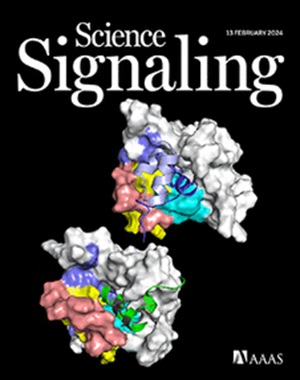Molecular determinants for the endocytosis of the voltage-gated K+ channel Kv1.3
IF 6.6
1区 生物学
Q1 BIOCHEMISTRY & MOLECULAR BIOLOGY
引用次数: 0
Abstract
The voltage-gated potassium channel Kv1.3 contributes to action potential conduction in sensory neurons and to sustained increases in cytoplasmic Ca2+ that activate immune cells. Here, we found that two distinct endocytosis-inducing stimuli acted through the same residues in Kv1.3 to control surface abundance and activity of the channel. Upon stimulation of the growth factor receptor EGFR, which stimulates Tyr-directed kinases and is important in neuronal differentiation, or of the Ser/Thr kinase PKC, which participates in the down-regulation of inflammatory responses, Kv1.3 underwent ubiquitination-dependent endocytosis that routed channel proteins to lysosomes for degradation. We mapped two lysine clusters in the N and C termini of Kv1.3, both of which became ubiquitinated upon activation of either Tyr or Ser/Thr kinases and whose combined mutation had an additive effect in reducing ubiquitination and endocytosis. Manipulations that prevented the ubiquitination or decreased the endocytosis of Kv1.3 resulted in increased Kv1.3 abundance at the immunological synapse and activity in primary human T cells. Prolonged channel accumulation at this location would be expected to increase Kv1.3-dependent leukocyte activation and lead to chronic inflammatory pathologies. Thus, ubiquitination fine-tunes cell biology by inducing the endocytosis and turnover of Kv1.3 in response to biological stimuli and insults.
电压门控K+通道Kv1.3内吞作用的分子决定因素
电压门控钾通道Kv1.3有助于感觉神经元的动作电位传导和激活免疫细胞的细胞质Ca2+的持续增加。在这里,我们发现两种不同的内吞诱导刺激通过Kv1.3中相同的残基起作用,以控制通道的表面丰度和活性。在刺激生长因子受体EGFR(刺激酪氨酸定向激酶,在神经元分化中起重要作用)或丝氨酸/苏氨酸激酶PKC(参与炎症反应的下调)的刺激下,Kv1.3发生泛素化依赖性内吞作用,将通道蛋白输送到溶酶体进行降解。我们在Kv1.3的N和C端定位了两个赖氨酸簇,这两个赖氨酸簇在Tyr或Ser/Thr激酶激活时都被泛素化,它们的组合突变在泛素化和内噬作用中具有加性作用。阻止泛素化或减少Kv1.3的内吞作用的操作导致免疫突触中Kv1.3的丰度和活性增加。该位置的通道积累时间延长,预计会增加kv1.3依赖性白细胞的激活,并导致慢性炎症病理。因此,泛素化通过诱导Kv1.3的内吞作用和周转来对生物刺激和损伤做出反应,从而微调细胞生物学。
本文章由计算机程序翻译,如有差异,请以英文原文为准。
求助全文
约1分钟内获得全文
求助全文
来源期刊

Science Signaling
BIOCHEMISTRY & MOLECULAR BIOLOGY-CELL BIOLOGY
CiteScore
9.50
自引率
0.00%
发文量
148
审稿时长
3-8 weeks
期刊介绍:
"Science Signaling" is a reputable, peer-reviewed journal dedicated to the exploration of cell communication mechanisms, offering a comprehensive view of the intricate processes that govern cellular regulation. This journal, published weekly online by the American Association for the Advancement of Science (AAAS), is a go-to resource for the latest research in cell signaling and its various facets.
The journal's scope encompasses a broad range of topics, including the study of signaling networks, synthetic biology, systems biology, and the application of these findings in drug discovery. It also delves into the computational and modeling aspects of regulatory pathways, providing insights into how cells communicate and respond to their environment.
In addition to publishing full-length articles that report on groundbreaking research, "Science Signaling" also features reviews that synthesize current knowledge in the field, focus articles that highlight specific areas of interest, and editor-written highlights that draw attention to particularly significant studies. This mix of content ensures that the journal serves as a valuable resource for both researchers and professionals looking to stay abreast of the latest advancements in cell communication science.
 求助内容:
求助内容: 应助结果提醒方式:
应助结果提醒方式:


